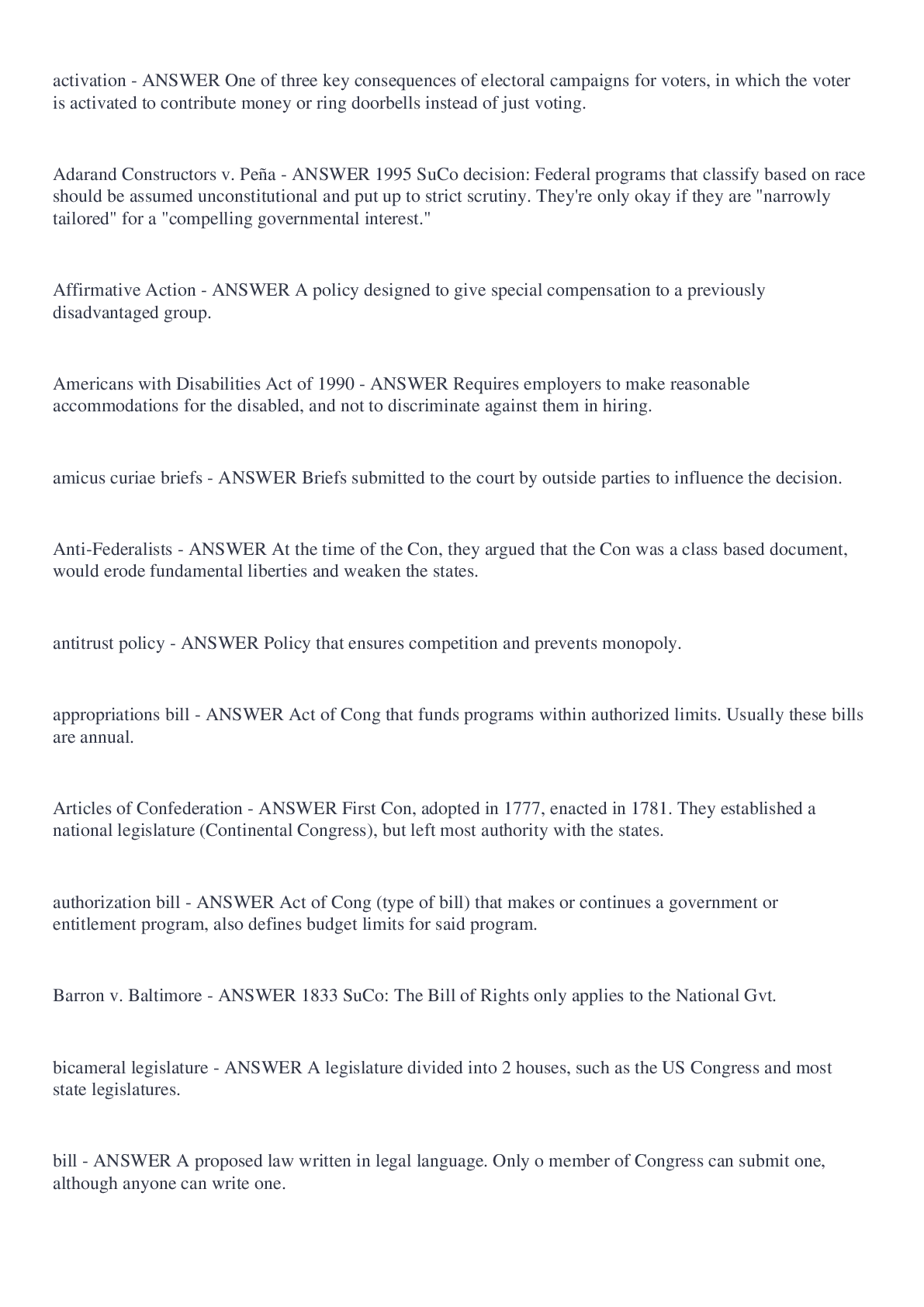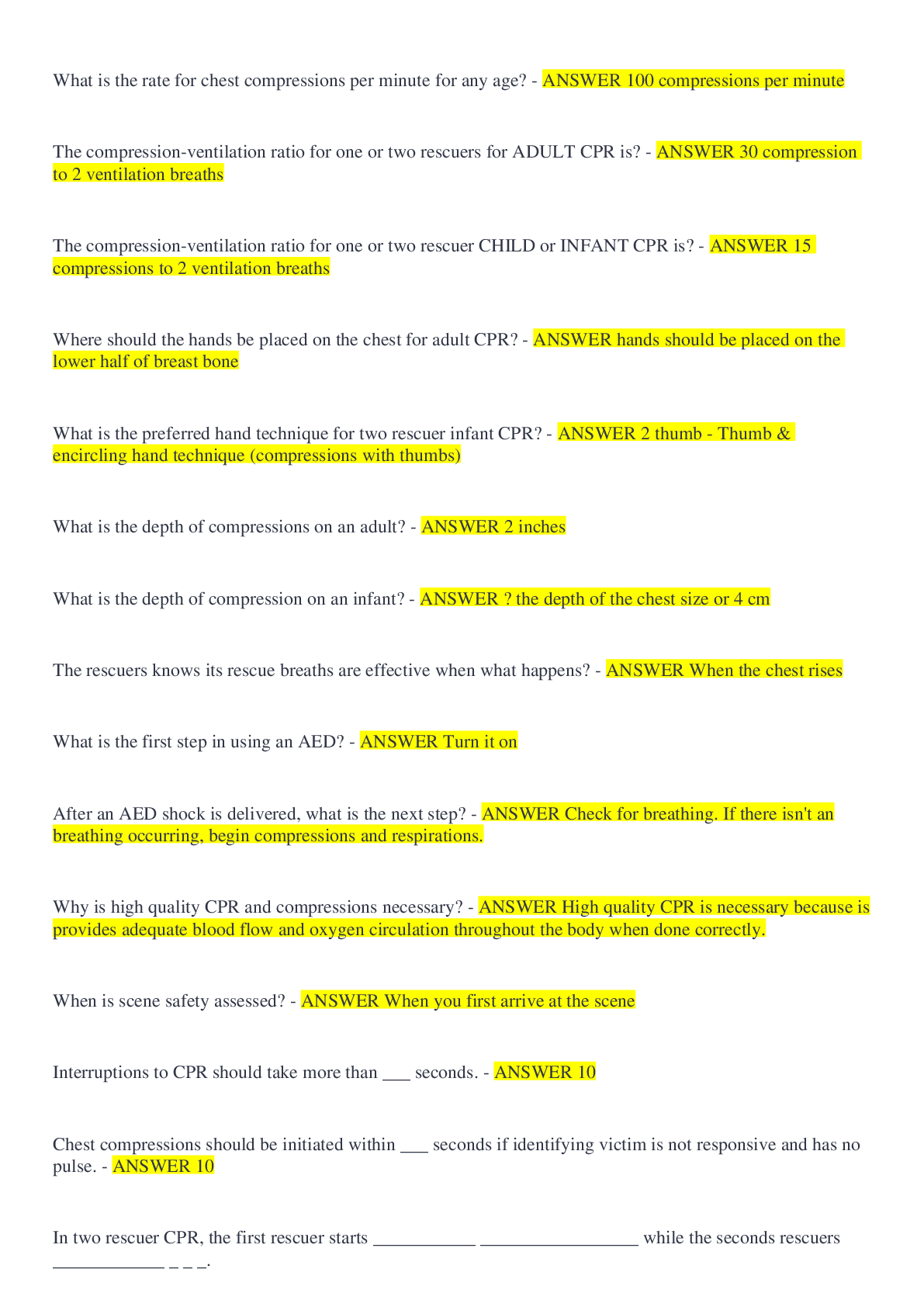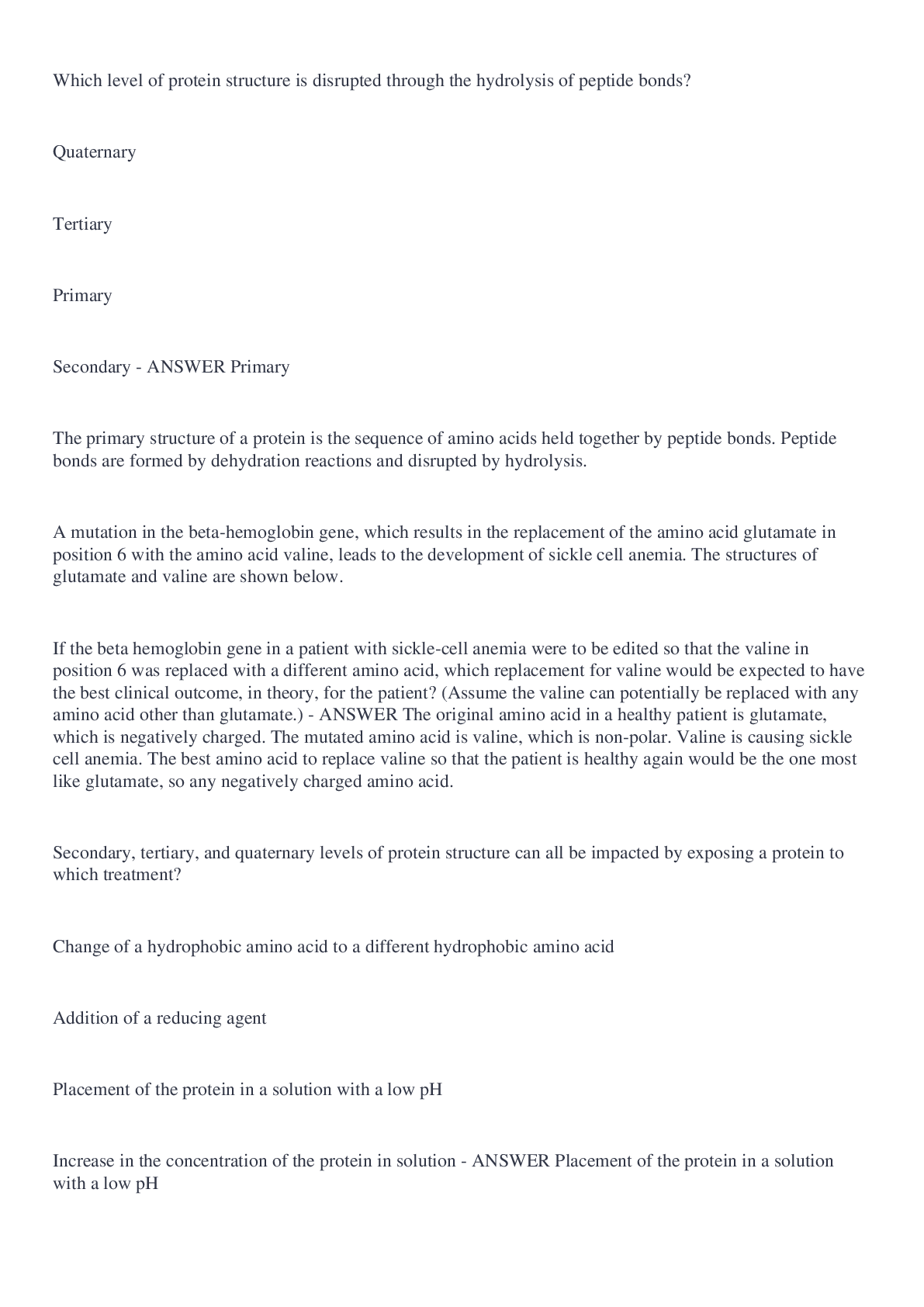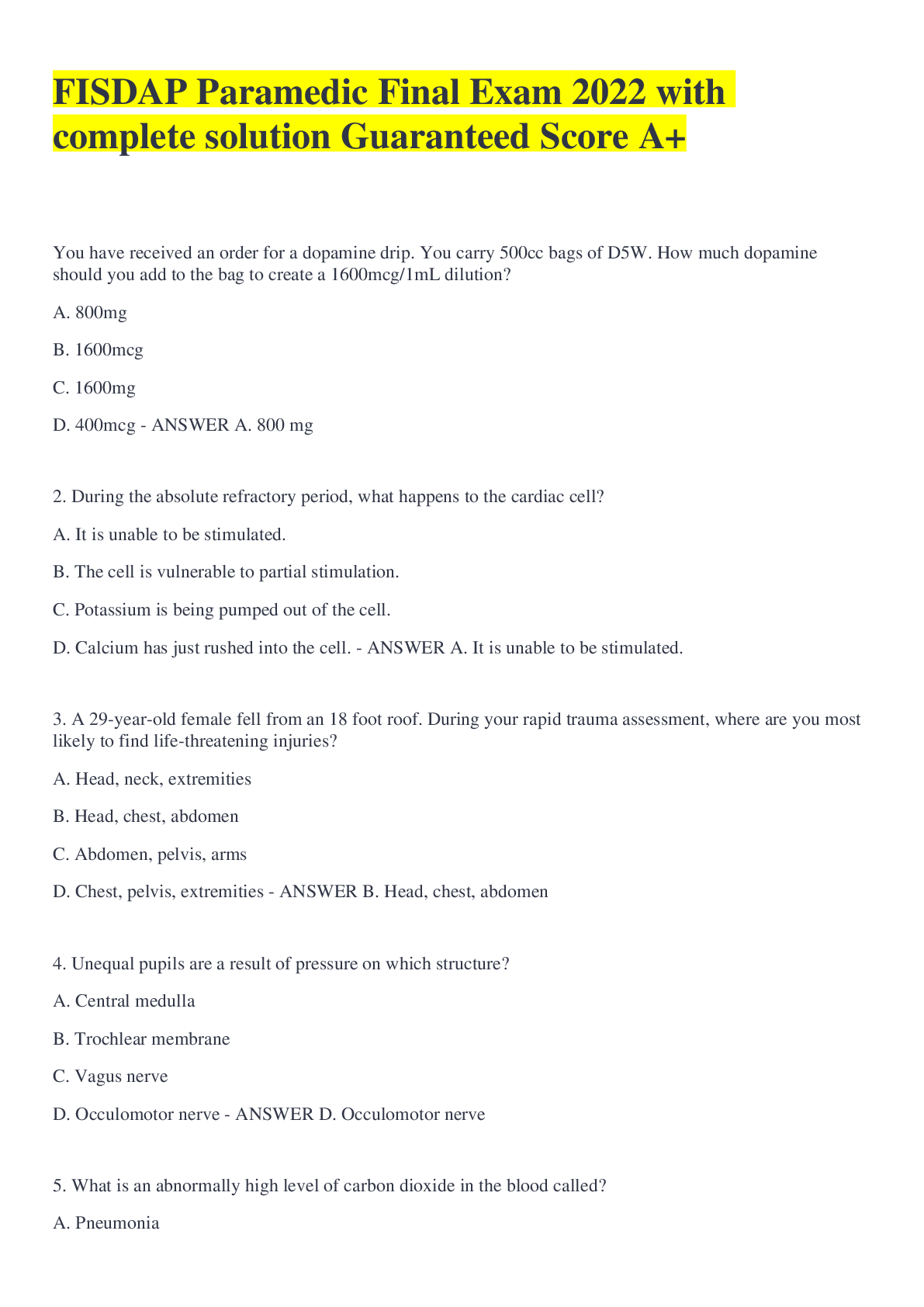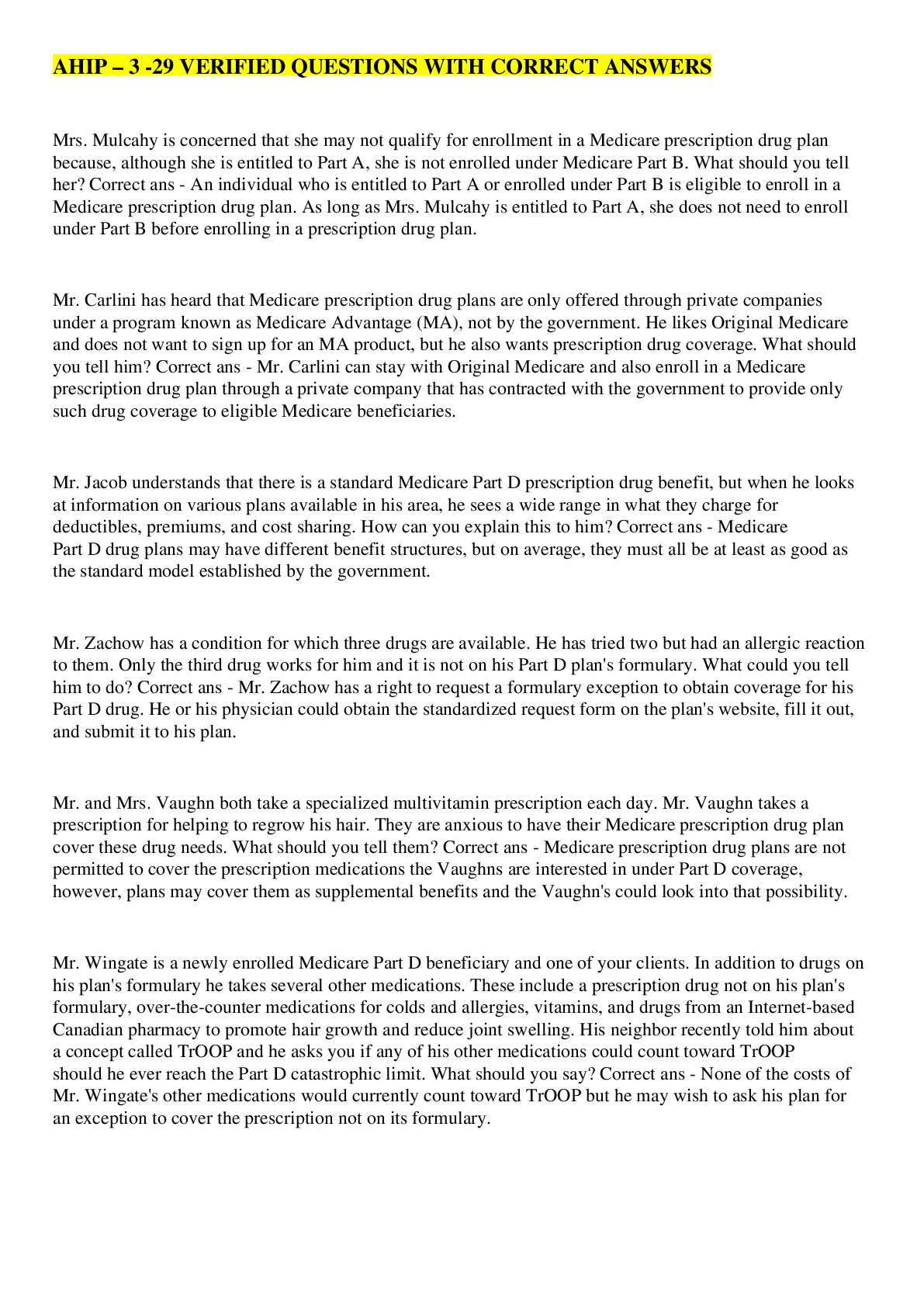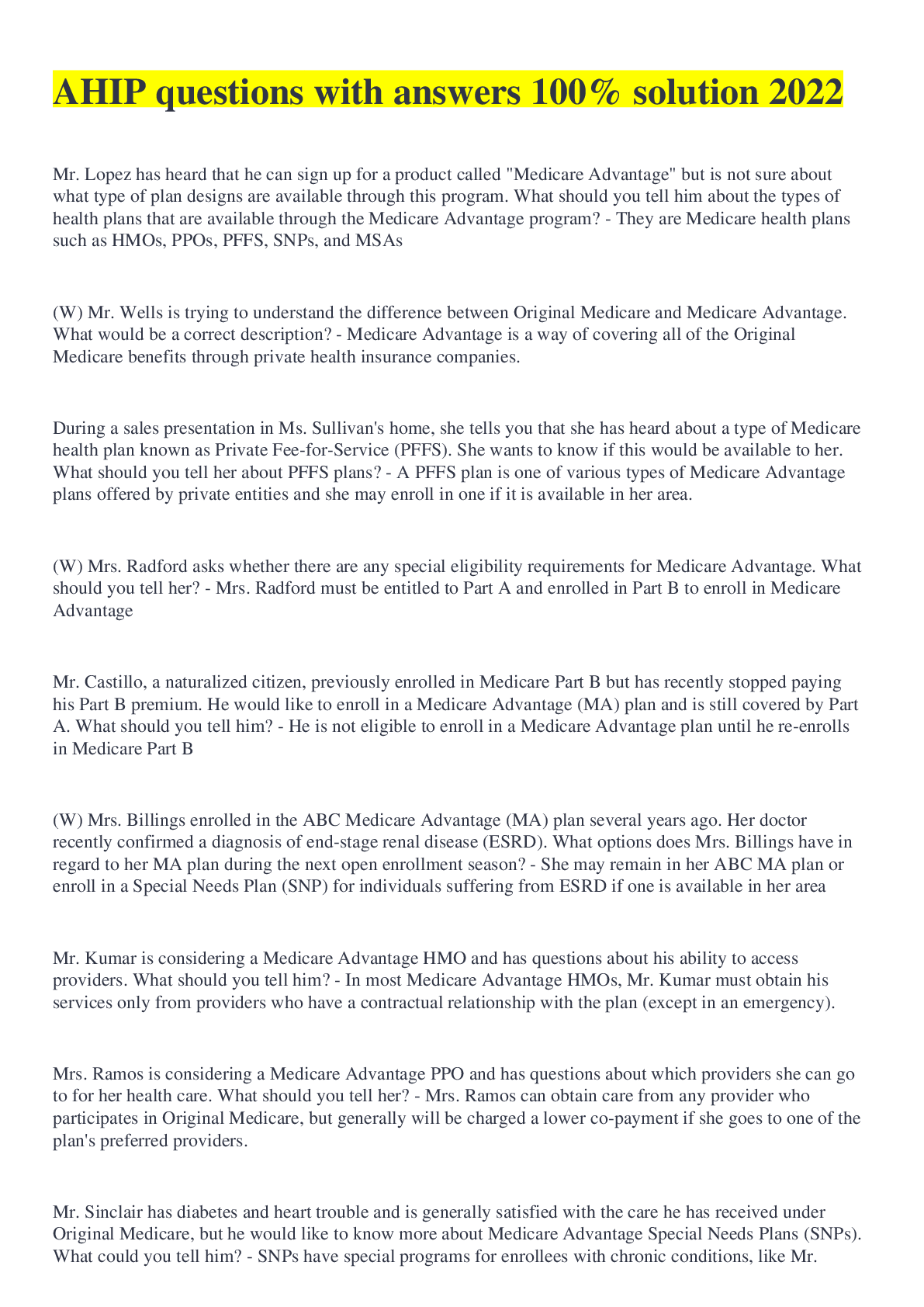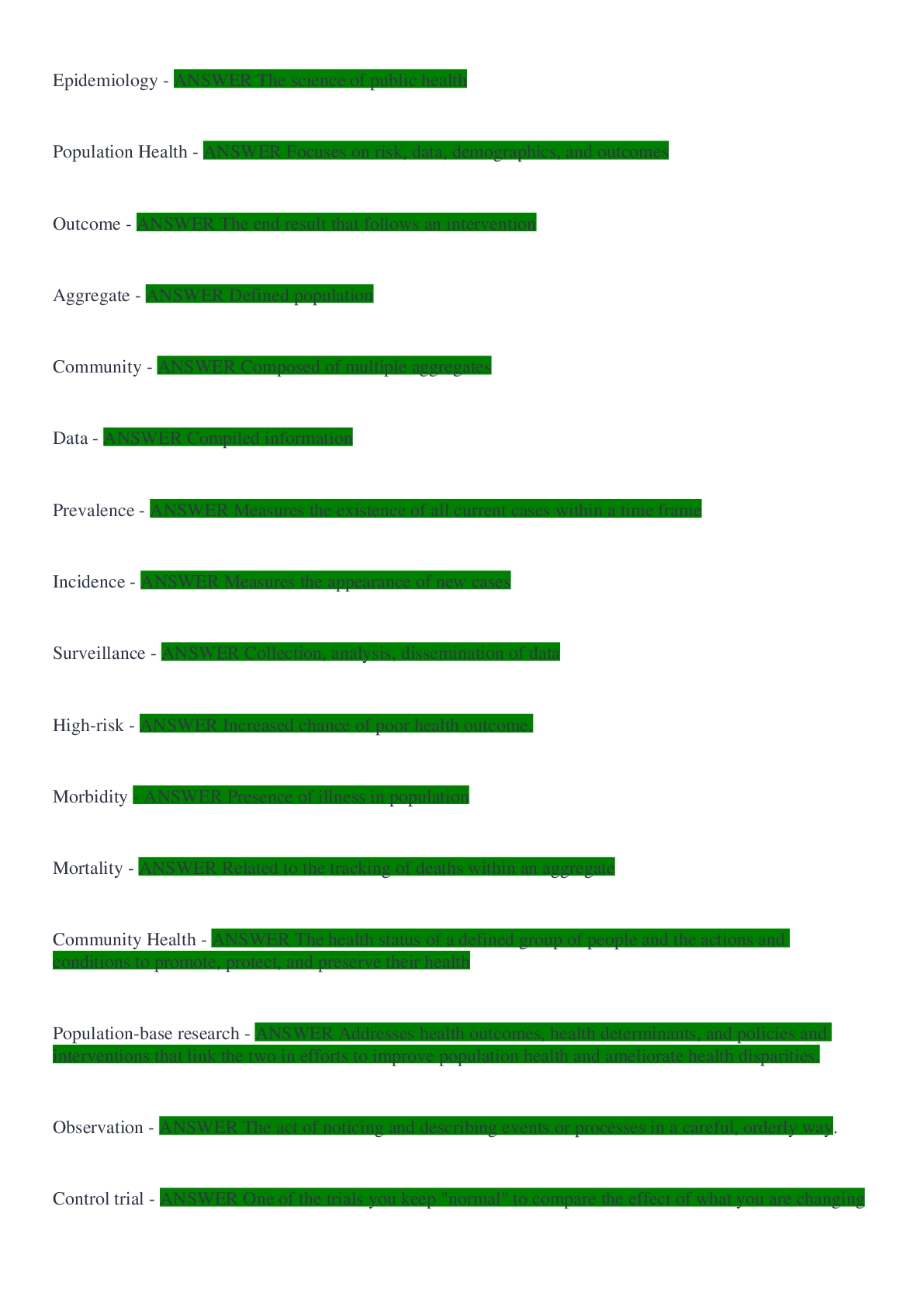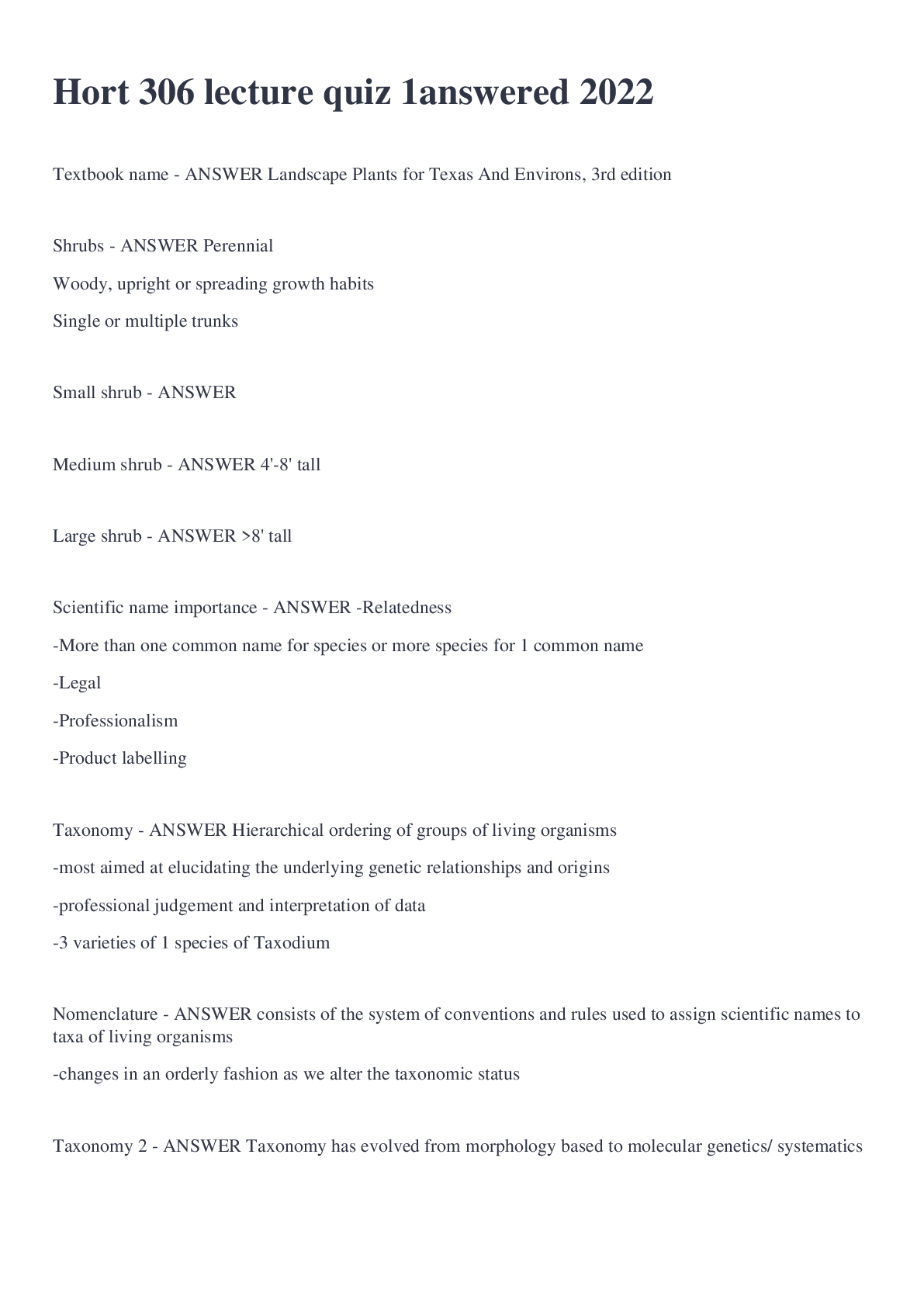Medicine > QUESTIONS & ANSWERS > Addiction Counselor Practice Test Book Latest Answered questions Score mark 98% (All)
Addiction Counselor Practice Test Book Latest Answered questions Score mark 98%
Document Content and Description Below
1. A wife refers her husband for substance abuse counseling. His drug of choice is cocaine, which he has been using episodically with friends at a poker game—biweekly to weekly—for some years. She... is disturbed at the illicit nature of the drug and the long-standing use. He states that though he recreationally uses, he does not crave cocaine, does not seek it out but rather uses with friends at the game who bring it, and he feels that other than his wife being upset about him using, he has no other social or occupational issues. Given the information provided, how is his use of cocaine BEST described? a. Substance abuse b. Cocaine intoxication c. Cocaine use disorder d. None of the above - ANSWER *D. None of the above* The DSM lists a set of eleven symptoms, 2 or more of which must have occurred at any time during the past 12 months for a diagnosis of substance use disorder. 1) Tolerance, defined as either the need for larger and larger amounts of the drug in question over time to achieve the desired result, or a decrease in the effect of the drug with continued use of the same amount 2) Withdrawal, defined by either the known withdrawal symptoms for a particular drug, or by the fact that the drug, or a similar drug, is taken to avoid withdrawal symptoms 3) An increase in the amount of the drug taken, or the continued use of the drug past the intended time 4) An inability to control usage 5) A large amount of time and effort devoted to obtaining the drug in question, using the drug in question, or recovering from its effects 6) The giving up of important activities in order to obtain or use the drug in question, or recover from its effects 7) The continued use of the drug in question regardless of the ill effects it has caused. 8) Craving 9) Recurrent drug use which leads to inability to fulfil major role 10) Recurrent drug use though it is physically harmful 11) Recurrent drug use despite it leading to continued social problems. He does not meet the criteria for current intoxication either. Recreational use commonly occurs biweekly or weekly, and the use is typically for reasons of sociality. Substance abuse counseling is therefore not indicated. However, counseling regarding the potential for life circumstances, stressors, or other unexpected losses or burdens to precipitate a future substance abuse problem should be discussed. 2. What does the experienced effect of a drug depend upon? a. The amount taken and past drug experiences b. The modality of administration c. Poly drug use, setting, and circumstance d. All of the above - ANSWER *D: All of the Above* The amount of a drug ingested will typically affect the user's experience, with higher doses often producing a greater effect (though potentially diminishing over time as tolerance develops). The modality of administration can greatly influence the rate of the drug's uptake into the system. Normally the rate of effect, from greatest to least, is: inhalation (snorting or smoking), injection (intravenous, intramuscular, or subcutaneous), and ingestion (sublingual or swallowing with or without food). Generally, the faster the systemic uptake, the shorter and more intense the high experienced. Polydrug abuse greatly complicates the drug experience, particularly if the drugs used are chemical antagonists (e.g., stimulants and depressants—such as meth and alcohol), additive (producing a cumulative effect), synergistic (more than cumulative), or potentiating (each enhancing each other). The setting in which the substance use occurs is also often a significant contributor to the experience. The feelings engendered by the surroundings, the people with whom the experience is shared, the attitudes and reactions of others involved, as well as personal past drug experiences and individual biology all combine to produce a drug experience. 3. How is drug tolerance BEST described? a. The inability to get intoxicated b. The need for more of a drug to get intoxicated c. Increased sensitivity to a drug over time d. Decreased sensitivity to a drug over time - ANSWER *D: Decreased sensitivity to a drug over time* When a drug is used regularly, the body is gradually able to adapt to the effects of the drug. Evidence of tolerance is twofold: (1) greater doses of the drug are required to achieve previous effects, and (2) doses that would have produced profound physiological compromise or even death are now readily tolerated without untoward effects. In some cases, it has been noted that up to ten times a lethal dosage, or even more, may be taken without any signs of significant physiological compromise. Tolerance develops as the body seeks homeostasis, or a functional state of equilibrium, in spite of the presence of the drug. 4. Which of the following is NOT a "drug cue"? a. A prior drug-use setting b. Drug use paraphernalia c. Seeing others use drugs d. Drug avoidance strategies - ANSWER *D: Drug avoidance strategies* Intense drug euphoria produces extremely intense, emotionally imprinted memory engrams, coupled with long-term changes in the amygdala area of the brain, which operate outside of conscious control. Key euphoric memories become integrally connected to sights, sounds, smells, people, and places previously associated with drug use. The reappearance of any of these past drug cues will often effectively trigger intense, amygdala-driven cravings for a drug. Cravings are further intensified by lingering imbalances in brain metabolism patterns, receptor availability, hormone levels, and other hypothalamus and pituitary-mediated sensations of dysphoria and distress. The cascading nature of these effects frequently induces a drug-use relapse. 5. What happens as tolerance for barbiturates develops? a. The margin between intoxication and lethality increases. b. The margin between intoxication and lethality decreases. c. The margin between intoxication and lethality stays the same. d. Tolerance does not develop for barbiturates. - ANSWER *C: The margin between intoxication and lethality stays the same. While tolerance for barbiturates does develop, tolerance for an otherwise lethal dose only marginally increases and never exceeds twofold. This means that the likelihood of an unintentional fatal dose increases substantially over time as the need for the intoxicating effect pushes that threshold ever closer to a lethal dose. Given the impairments in memory and judgment that typically accompany CNS depressant intoxication, simple forgetfulness can lead to a fatal overdose. Finally, using barbiturates with any other CNS depressant substance, such as alcohol, can result in an additive CNS depression that can readily be fatal. Death most often occurs via respiratory or cardiac suppression. 6. What is the MOST common symptom of Wernicke's encephalopathy? a. New memory formation b. Loss of older memories c. Psychosis d. Confusion - ANSWER *D: Confusion* Other symptoms of Wernicke's encephalopathy include poor muscle coordination and oculomotor impairment (problems moving the eyes in a controlled fashion). Wernicke's syndrome is a short-term condition resulting from vitamin B1 (thiamine) deficiency, typically developing after years of drinking and poor nutrition. Of those with Wernicke's syndrome, 80 to 90 percent will develop long-term psychosis and memory problems known as Korsakoff syndrome. While poor coordination is a symptom, retrograde amnesia (loss of old memories) and learning impairments are among the more classic hallmarks of the condition. Because they are so often found together, the two syndromes are often referred to concurrently as Wernicke-Korsakoff syndrome. 7. Which of the following conditions does alcohol NOT induce? a. Steatosis b. Nephrosis c. Hepatitis d. Cirrhosis - ANSWER *B: Hepatitis* Hepatitis refers to inflammation of the liver. Alcohol is toxic to all body tissues. Because alcohol must be metabolized by the liver, it is particularly susceptible to the toxic effects. Consequently, many heavy drinkers suffer from alcoholic hepatitis, characterized by abdominal pain, nausea, vomiting, and a swollen liver. In more extreme cases, jaundice and bleeding can result. Jaundice (a yellowing of the skin and whites of the eyes) is from bilirubin, a by-product of aging red blood cells broken down in the liver, that should have been fully metabolized by the liver. Spontaneous bleeding occurs because key clotting factors are made in the liver, but production is inhibited by hepatitis. Steatosis consists of fatty deposits in the liver that, if severe, can prove fatal. Cirrhosis refers to scarring of the liver from alcohol damage, preventing its normal functioning. High blood toxins can also cause hepatic encephalopathy—a reversible dementia—if the toxins are reduced. 8. What does formication refer to? a. The creation of freebase cocaine b. Sex between two unmarried individuals c. A sensation of bugs crawling under the skin d. Extrapyramidal symptoms of agitation - ANSWER *C: A sensation of bugs crawling under the skin* Chronic users of cocaine, crack cocaine, methamphetamine, and other such stimulants develop a profoundly unpleasant sensation of bugs crawling under their skin. They may even come to believe the bugs are present and needing to be removed. In less severe cases, users may pick at their skin to the point of causing sores and scabs. In more extreme cases, users may cut themselves in a desperate attempt to release the bugs and find relief. The condition is also known as Magnon's syndrome and may also be referred to colloquially as coke bugs or crank bugs, and so on. 9. What is/are the organ(s) most [Show More]
Last updated: 3 years ago
Preview 1 out of 66 pages
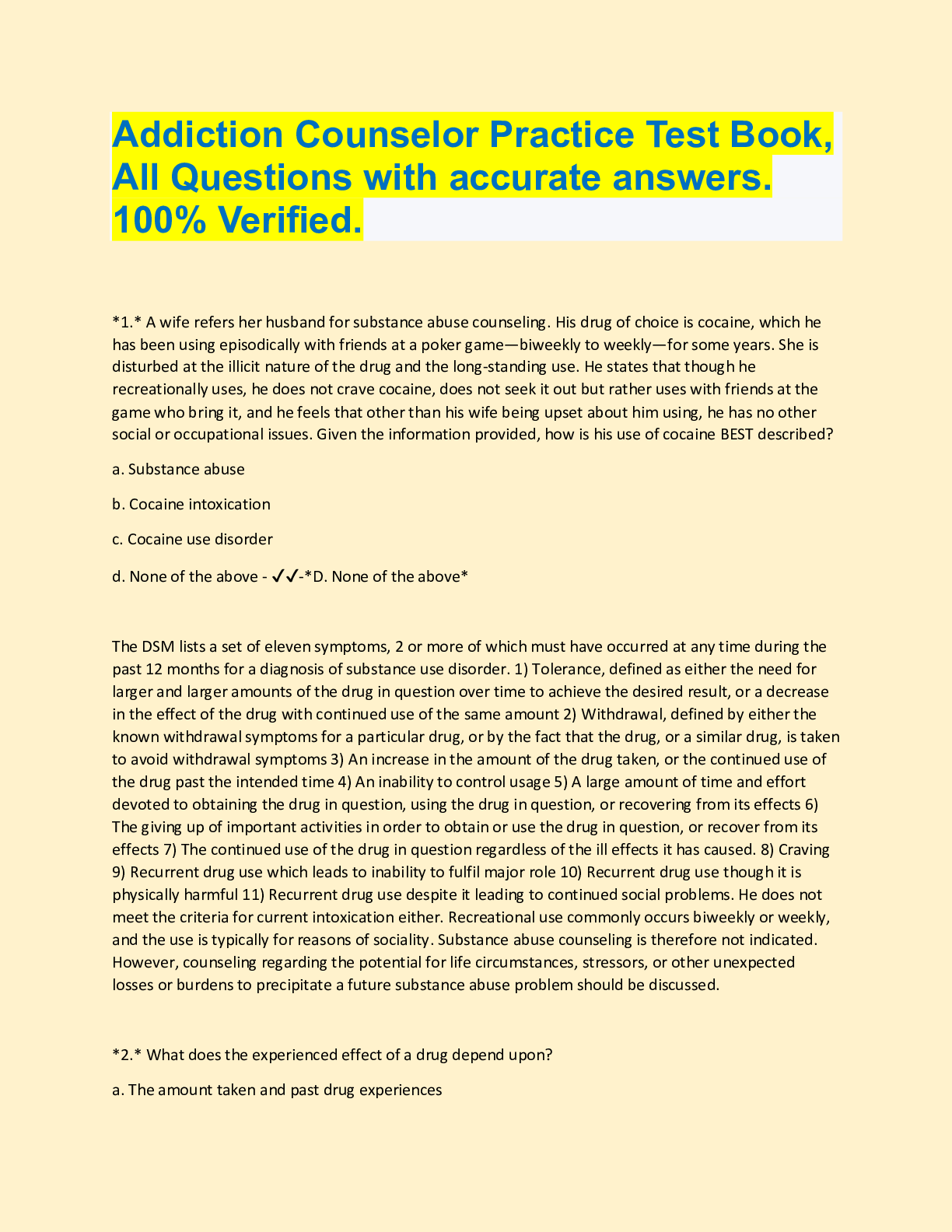
Buy this document to get the full access instantly
Instant Download Access after purchase
Buy NowInstant download
We Accept:

Reviews( 0 )
$12.00
Can't find what you want? Try our AI powered Search
Document information
Connected school, study & course
About the document
Uploaded On
Aug 12, 2022
Number of pages
66
Written in
Additional information
This document has been written for:
Uploaded
Aug 12, 2022
Downloads
0
Views
63


